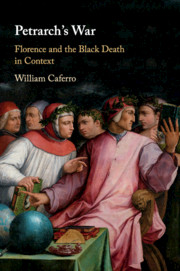Book contents
- Petrarch’s War
- Petrarch’s War
- Copyright page
- Contents
- Figures, Maps, and Tables
- Preface and Acknowledgments
- Introduction: The Plague in Context: Florence 1349–1350
- 1 Petrarch’s War
- 2 The Practice of War and the Florentine Army
- 3 Economy of War at a Time of Plague
- 4 Plague, Soldiers’ Wages, and the Florentine Public Workforce
- 5 The Bell Ringer Travels to Avignon, the Cook to Hungary
- Epilogue: Why Two Years Matter (and the Short-Term Is Not Inconsistent with the Long-Term)
- Bibliography
- Index
- References
Bibliography
Published online by Cambridge University Press: 12 June 2018
- Petrarch’s War
- Petrarch’s War
- Copyright page
- Contents
- Figures, Maps, and Tables
- Preface and Acknowledgments
- Introduction: The Plague in Context: Florence 1349–1350
- 1 Petrarch’s War
- 2 The Practice of War and the Florentine Army
- 3 Economy of War at a Time of Plague
- 4 Plague, Soldiers’ Wages, and the Florentine Public Workforce
- 5 The Bell Ringer Travels to Avignon, the Cook to Hungary
- Epilogue: Why Two Years Matter (and the Short-Term Is Not Inconsistent with the Long-Term)
- Bibliography
- Index
- References
- Type
- Chapter
- Information
- Petrarch's WarFlorence and the Black Death in Context, pp. 200 - 219Publisher: Cambridge University PressPrint publication year: 2018



